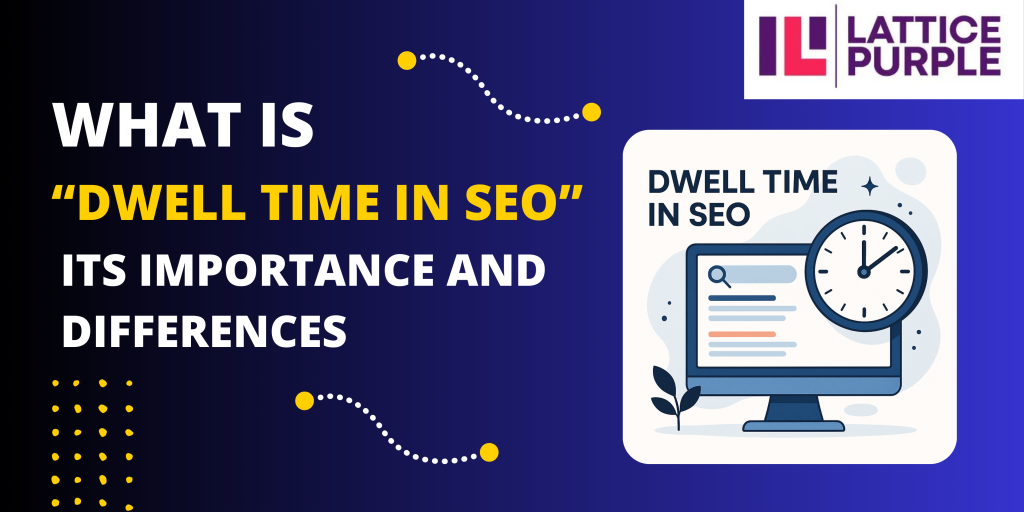One of the key metrics that frequently arises in discussions among marketers is “dwell time”. This metric is often seen as a crucial indicator of user engagement and content relevance, yet many are still unclear about its precise nature and implications. This article aims to demystify dwell time, explain its significance in the broader digital landscape, and explore how it can impact user experience and affect key performance indicators such as bounce rates.
What is “Dwell Time” in SEO
Dwell time is a specific metric that refers to the duration a visitor remains on a webpage after clicking through from a search engine result, and before returning to the search engine results page (SERP). It serves as a measure of how engaging and relevant users find your content after being attracted by the search result snippet. Unlike some other popular metrics, dwell time zeroes in on the user’s interaction with the page immediately following a search result click, rather than general site-wide engagement.
How Dwell Time Differs from Other Metrics
In the realm of web analytics, it is easy to conflate dwell time with other similar-sounding metrics, but understanding their distinct differences is crucial. Bounce rate, for example, measures the percentage of single-page visits where the user leaves without further interaction, providing a different lens on user engagement. Dwell time, however, looks specifically at how long a user stays on a page before returning to the SERP, making it a more focused indicator of content relevance. Meanwhile, session duration measures the total time a user spends across your entire site, encompassing multiple pages until the session ends.
By distinguishing these metrics, you can appreciate why dwell time is uniquely valuable. It offers insights that can help refine your content strategy by highlighting how well specific pages meet user expectations immediately after a search.
With the growing influence of large language models (LLMs) and AI marketing, businesses now have more advanced tools to interpret these metrics. These technologies enable deeper analysis, uncover patterns in user behavior, and support the creation of highly targeted, relevant content that can improve dwell time and overall engagement.
The Importance of Dwell Time
Dwell time is a critical metric that holds significant implications for both SEO and user experience. It provides a window into how effectively your content satisfies user needs and expectations.
Impact on SEO
Search engines like Google are constantly striving to provide the most relevant and valuable results for users’ queries. Although Google has not officially confirmed that dwell time is a direct ranking factor, it is widely speculated to influence the search algorithm indirectly. A longer dwell time suggests that users find your content engaging and valuable, which can contribute positively to your search rankings.
When search engines detect that users frequently return to the SERP shortly after visiting a page, they may interpret this behavior as a sign of irrelevance or poor user engagement. Over time, this could lead to lower search rankings as the algorithm strives to prioritize more engaging content that better satisfies user intent.
Enhancing User Experience
From the perspective of user experience, dwell time serves as a practical measure of content quality and relevance. If users spend considerable time on your page, it indicates they are finding the information helpful and engaging. This can lead to higher satisfaction levels, increased trust, and a greater likelihood of converting visitors into loyal customers or subscribers.
By focusing on strategies to improve dwell time, you can create a more positive user experience, which can have a cascading effect on other important metrics such as conversion rates, customer retention, and overall brand loyalty.
Read Also – What is LLM.txt and How to Apply It
Factors Influencing Dwell Time
Several key factors contribute to dwell time, and understanding these can help you optimize your content and website design to foster better user engagement.
Content Quality and Relevance
The foremost driver of dwell time is the quality and relevance of your content. When your content aligns with the user’s search intent and offers valuable information, users are more inclined to remain on the page longer. High-quality content should be well-researched, accurate, and engaging, offering insights or solutions that meet user needs.
Creating content that resonates with users involves understanding their pain points and preferences. This can be achieved through thorough market research and by analyzing user feedback. By tailoring your content to address the specific questions and interests of your audience, you can increase the likelihood that users will find it compelling enough to engage with thoroughly.
Page Load Speed
Page load speed is a critical component of user experience that directly affects dwell time. A slow-loading page can frustrate users, prompting a quick exit and negatively impacting dwell time. Ensuring your website loads quickly is vital to keeping users engaged and reducing bounce rates.
Optimizing page load times involves technical improvements such as compressing images, minimizing HTTP requests, and enabling browser caching. These strategies not only enhance user satisfaction but also contribute to better SEO performance, as search engines favor fast-loading websites.
User-Friendly Design
A clean, intuitive website design can significantly enhance user experience and encourage visitors to explore your content further. Elements such as easy navigation, readable fonts, and a mobile-friendly layout all contribute to better dwell time.
A user-friendly design reduces friction points that might otherwise discourage users from engaging with your content. By providing a seamless browsing experience, you make it easier for users to find the information they need, thereby increasing the likelihood that they will stay on your site longer.
Multimedia Elements
Incorporating multimedia elements such as images, videos, and infographics can make your content more engaging and visually appealing. These elements help break up text and provide additional value to users, encouraging them to spend more time on the page.
Multimedia can cater to different learning styles and preferences, making your content accessible to a broader audience. Well-placed multimedia elements can illustrate complex concepts more effectively than text alone, enhancing user comprehension and retention.
Clear Call-to-Actions
Including clear and compelling call-to-actions (CTAs) can guide users on what to do next, whether it’s exploring more content, signing up for a newsletter, or making a purchase. Effective CTAs can help reduce bounce rates and increase dwell time by directing users to other parts of your site.
Strategically placed CTAs can create a natural flow through your site, encouraging users to continue their journey and engage with additional content. By aligning CTAs with user needs and interests, you can foster deeper engagement and drive desired actions.
Strategies to Improve Dwell Time
Improving dwell time requires a strategic approach that focuses on enhancing content, design, and user experience.
Optimize Content for Search Intent
Understanding and aligning with user search intent is crucial for improving dwell time. Conduct thorough keyword research to identify what users are actively searching for, and tailor your content to meet those needs. Ensure that your headlines, subheadings, and meta descriptions accurately reflect the content of your page, creating a cohesive and compelling narrative.
By aligning your content with search intent, you increase the likelihood that users will find what they are looking for, reducing the chances of them returning to the SERP in search of better answers.
Enhance Readability
Make your content easy to read by using short paragraphs, bullet points, and subheadings. A well-structured article encourages users to read through to the end, increasing dwell time.
Readability is not just about simplifying language; it’s about presenting information in a way that is accessible and inviting. Use of visuals, varied sentence structures, and engaging storytelling can all contribute to a more enjoyable reading experience.
Include Engaging Visuals
Adding relevant images, videos, and infographics can capture users’ attention and keep them engaged with your content. Ensure that all visuals are high-quality and serve a purpose in enhancing the message of your page.
Visuals can also support your brand identity and help convey complex information more effectively. By integrating visuals strategically, you can create a more immersive and memorable user experience.
Read Related – What is E-E-A-T ? and its Importance, Role, and Optimization in SEO
Improve Internal Linking
Internal linking helps guide users to additional content on your site, which can increase dwell time and reduce bounce rates. Use descriptive anchor text and ensure that links lead to relevant, high-quality content.
A robust internal linking strategy can help users discover more of your content, increasing the likelihood of prolonged site engagement. It also helps search engines better understand the structure and hierarchy of your site, potentially benefiting your SEO efforts.
Regularly Update Content
Keeping your content fresh and up-to-date is important for maintaining relevance and accuracy. Regularly review and update your pages to reflect new information, trends, and user needs.
Frequent updates signal to users and search engines alike that your site provides current, authoritative information. This practice not only helps maintain high dwell times but also contributes to building trust and authority in your niche.
Conclusion
Dwell time is a valuable metric that provides insights into user behavior, content relevance, and overall user experience. By focusing on strategies to improve dwell time, you can enhance the quality of your content, boost user engagement, and potentially improve your search engine rankings. Prioritizing dwell time as part of your SEO and content strategy can lead to a more successful and user-friendly website.
Incorporating dwell time into your digital strategy involves a holistic approach, considering both technical and content-related factors. By understanding and addressing the elements that influence dwell time, you can create a more engaging, informative, and satisfying experience for your users, ultimately driving better results for your digital marketing efforts.




